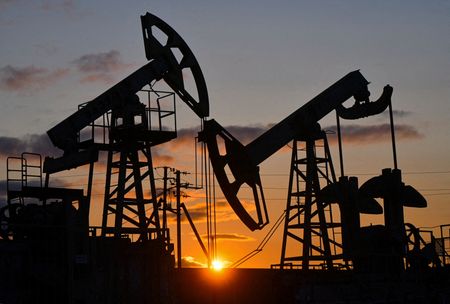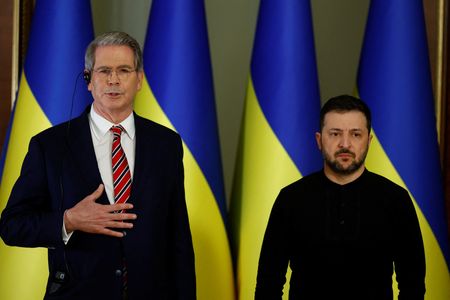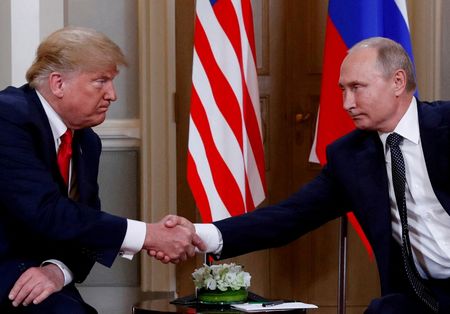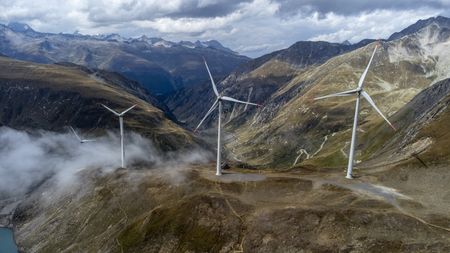By Anna Hirtenstein and Florence Tan
LONDON/SINGAPORE (Reuters) – Russia may be forced to throttle back its oil output in the coming months as U.S. sanctions hamper its access to tankers to sail to Asia and Ukrainian drone attacks hobble its refineries.
The United States imposed sanctions last month that targeted 180 Russian tankers while Kyiv has stepped up drone attacks to improve its bargaining position amid expectations that U.S. President Donald Trump will press Russian leader Vladimir Putin to negotiate an end to the war in Ukraine.
Trump has said stopping the conflict is a priority and that he could impose new sanctions on Russia if his goals are not achieved.
Reuters has spoken to three oil executives and more than 10 traders, refining executives, and port agents about the impact of these latest sanctions.
Three Russian oil executives, asking not to be named due to the sensitivity of the issue, said the reality was clear: Russia will have no choice but to slow oil production.
There is a growing glut of crude in Russia due to falling exports and reduced refining production which can only be addressed by lowering output, they said. Russia has little storage capacity and Ukraine has attacked some of these facilities with drones in recent weeks.
The output cuts could start small, with Russia’s production slipping below 9 million barrels per day (bpd) in the coming months, but may accelerate if tanker shortages and refining outages persist, the executives said.
There are already signs of weakening crude exports in trading data.
Volumes from Russia’s western ports of Primorsk, Ust-Luga, and Novorossiisk in January were down 17% from a year earlier, Reuters calculations based on traders’ data showed.
Russia no longer publicly discloses its export data.
Three years into the war, Russia has withstood wave after wave of sanctions, including the G7 imposing a $60 per barrel price cap on its oil sales. U.S. sanctions have not aimed to stop Russian exports, but to cap the price at which Russia can sell and to ensure it complies with the rules.
Most European buyers walked away, but China and India have increased purchases, taking oil at a generous discount.
SHADOW FLEET
Russia has looked to minimise the impact of sanctions by amassing a fleet of own tankers, often called the “shadow fleet” as it does not use Western services and insurance.
The latest U.S. sanctions have hit that fleet hard. Washington said it was taking sweeping action against Russia’s energy industry, Moscow’s key source of revenue.
The impact has been swift, with the cost to transport a cargo from Russia’s Pacific port of Kozmino to China up fivefold in January, trader data showed.
Traders and shipbrokers said the sanctions have closed some Chinese and Indian ports to a fifth of the fleet.
Many Chinese and Indian buyers are also now insisting on deliveries using tankers not targeted by the sanctions and are buying more Saudi, UAE, and Iraqi oil, traders said.
As a result, Russian firms and traders have stored 17 million barrels aboard ships since Jan. 10, up from zero at the start of the year, Goldman Sachs estimates. The figure could rise to 50 million barrels in the first half of 2025.
The rate of idling and drifting by ships carrying Russian fuel has risen by 300% in some areas, Windward, a marine analytics firm, estimates. Many are anchored in the Sea of Crete and waters off the coast of Portugal and Madagascar, it said.
Russia’s Arctic fields producing over 300,000 bpd are struggling to find tankers and may cut output, traders said.
Moscow has already accepted lower crude output levels in agreement with Saudi Arabia and others in the so-called OPEC+ group of oil-producing countries.
Those cuts are aimed at supporting oil markets, but they also reduce Moscow’s potential income.
Collectively OPEC+ members plan to begin easing their output cuts from April but for Russia that may now prove more difficult.
Putin already faces a budget deficit that has totalled more than $100 billion since the war began, finance ministry statements and data show. Any hit to oil income impacts the economy directly, with oil revenue of $192 billion in 2024, according to the International Energy Agency.
Russia’s federal revenue in 2024 totalled $383 billion, the finance ministry has said.
ATTACKS ON PLANTS
Russia’s daily output of around 9 million barrels, already well below a record 11.25 million reached in 2019, includes approximately 5 million bpd earmarked for its own refineries.
But there has been a rise in the number of Ukrainian drone attacks since January which have hit eight Russian refineries as well as oil depots and industrial sites.
The attacks have knocked out around 10% of Russian refining capacity, Reuters calculations based on traders’ data showed. Like its crude exports, Russia no longer makes refining data public.
Major sites including the Ryazan, Volgograd, and Astrakhan refineries have shut fuel production and it will take weeks or months to restore it, said industry sources familiar with the plants’ operations.
Ukraine also attacked Russia’s limited oil storage as well as pipelines and pumping stations, disrupting flows to export ports and refineries in January, traders said.
One of Russia’s biggest ports, Ust-Luga on the Baltic Sea, cut loadings to a four-year low in January, utilising only half its capacity, traders said, citing problems with pipelines.
ADAPTING TO SANCTIONS
Russia has built up a fleet of very large crude carriers (VLCCs) and mid-sized Suezmax tankers since 2022.
One of its responses to January’s sanctions has been to seek out smaller vessels.
Russian oil dealers have bought at least 12 smaller Aframax tankers since January to address the sudden shortage, one shipbroker familiar with the transactions said. He asked not to be named due to the sensitivity of the issue.
Aframax can carry up to 800,000 barrels, a Suezmax up to 1 million barrels, and a VLCC up to 2 million barrels.
Russia’s buying has helped boost prices for used Aframax tankers which have spiked to around $40 million from around $15 million last year, according to shipbrokers.
At the same time, the cost of shipping oil to China in an Aframax tanker has jumped to $6.5 million-$7.5 million from $1.5 million last year, traders said, though that is still well below the record $20 million seen when prices spiked in 2022.
Washington has said it sees Moscow’s spending more on tankers as a win as it diverts money from the war in Ukraine.
“Eventually, they will get other ships, other companies and so on,” said Adi Imsirovic, an analyst at the Surrey Clean Energy consultancy and former oil trader at Russia’s Gazprom. He said in the short term Russia will have to swallow the higher costs.
Many analysts including the International Energy Agency (IEA) have predicted a steep decline in Russian oil output since 2022, forecasts which have failed to materialise.
But one Russian oil executive told Reuters the level of complexity now involved in refining and selling oil was becoming too much.
“Everyone is waiting for this war to be over,” he said.
($1 = 95.8955 roubles)
(Reporting by Anna Hirtenstein in London, Florence Tan in Singapore; editing by Jason Neely)










